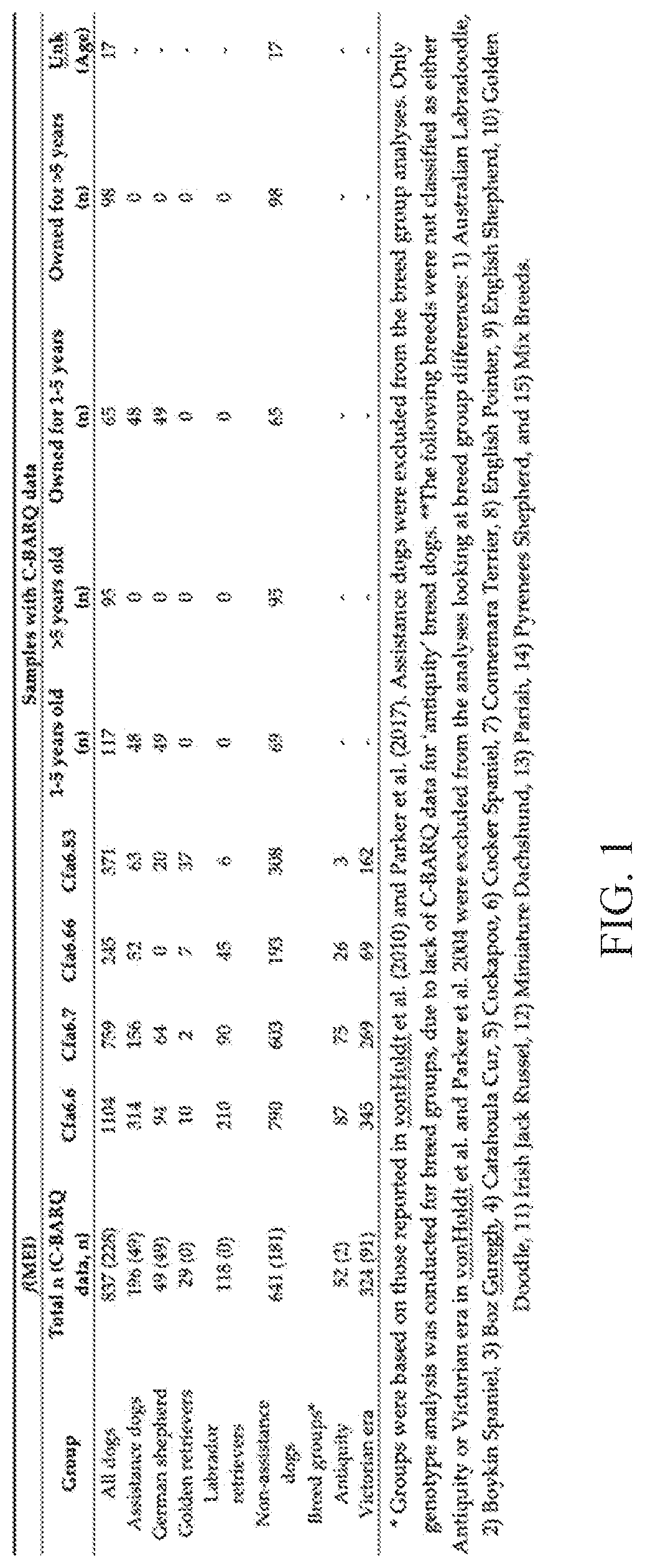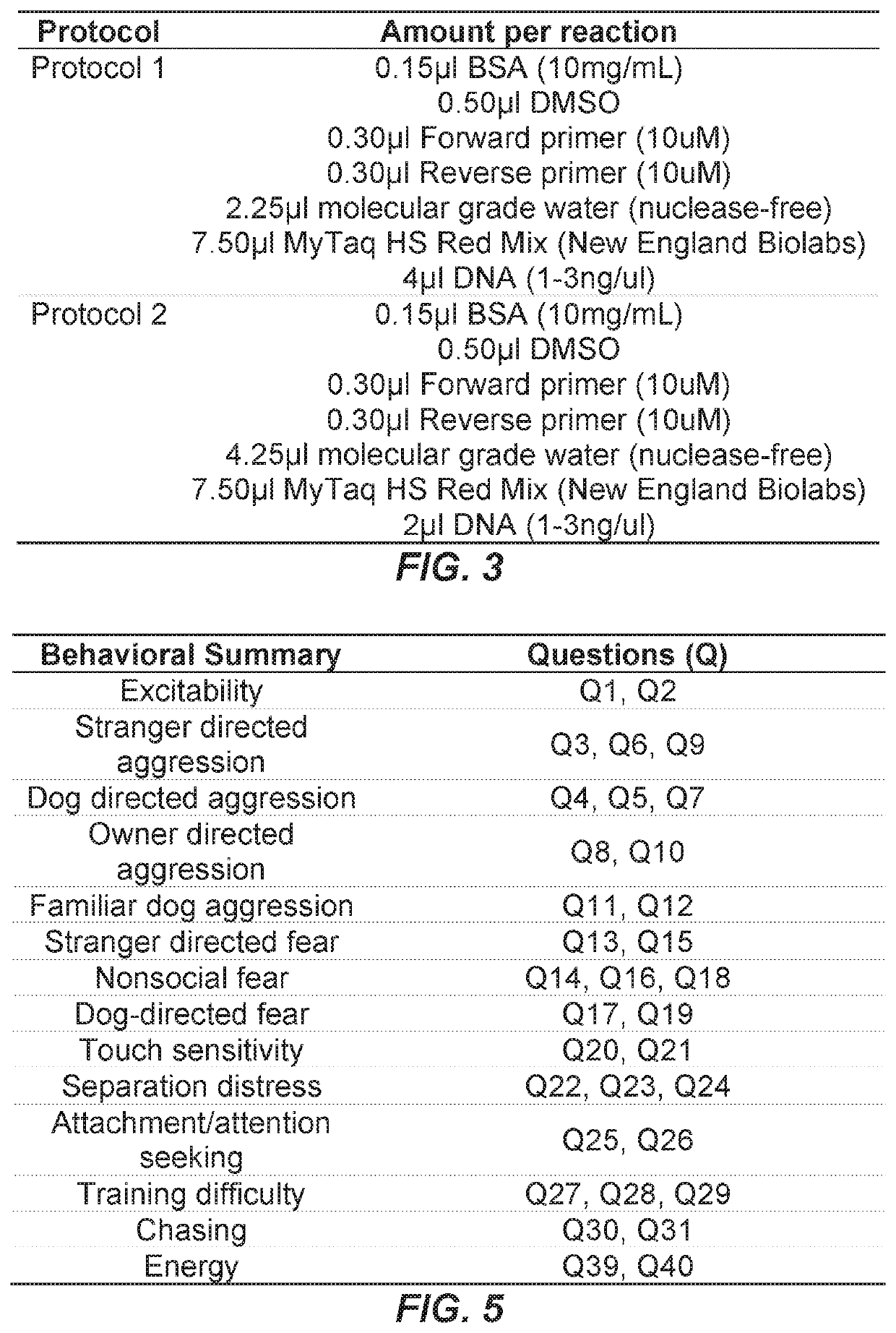Early genetic screening to aid in the selection of dogs for assistance training programs
a genetic screening and assistance training technology, applied in the field of early genetic screening to aid in the selection of dogs for assistance training programs, can solve the problems of compound limitations, behavioral assays likely face reduced accuracy in predicting adult behavior, and cannot be highly predictive of long-term positive behaviors, etc., to achieve the effect of displaying a sociable behavior
- Summary
- Abstract
- Description
- Claims
- Application Information
AI Technical Summary
Benefits of technology
Problems solved by technology
Method used
Image
Examples
example 1
[0037]Genotyping and Counting Four Mobile Element Insertions Associated with Human-Directed Hypersociability.
[0038]As part of a screen, DNA from 837 adult domestic dogs >1 year of age was isolated, 159 of which were whole blood samples and 678 from buccal cells or saliva using Qiagen's DNeasy Blood and Tissue Kit (Qiagen, Germantown, Md., USA). A summary can be seen in FIG. 1. The samples were derived across 74 breeds (n: purebred=656, mixed-breed=104, unknown=78), from 196 assistance dogs (sample size per breed: German Shepherds=56, Golden Retriever=29, Labrador Retriever=118) and 642 pet dogs. For all DNA isolated from buccal cells or saliva, a second purification step was completed using a 1:2 ratio of DNA to AMPure XP magnetic purification beads (Beckman Coulter Life Sciences, Indianapolis, Ind., USA). Previously published amplification methods were followed to genotype and survey the insertional dynamics of four MEIs implicated in canine hypersocial behavior. Amplicons between ...
example 2
[0045]Canine Questionnaire Data to Identify Behavioral Types
[0046]Of 837 dogs with genetic samples, 228 also had paired detailed demographic (age, sex, breed, DOB, and # years owned) and behavioral data derived from 42 questions of the C-BARQ (short version). As understood by those of skill in the art, the C-BARQ quantifies the behavioral tendencies of individual dogs (as assessed by an owner, handler, or evaluator) across 14 behavioral categories by averaging scores across related questions (See FIG. 5). Questions from the attachment, attention-seeking, and separation distress sections of the evaluation most closely parallel behavioral traits used to identify dogs displaying hypersociability (elevated proximity-seeking) in prior research by vonHoldt et al. (See FIG. 6). Additionally, stranger-directed aggression and stranger-directed fear quantify opposing behaviors towards unfamiliar people, and hence would be negatively correlated with prosocial interest in strangers (See FIG. 6)...
PUM
| Property | Measurement | Unit |
|---|---|---|
| Energy | aaaaa | aaaaa |
Abstract
Description
Claims
Application Information
 Login to View More
Login to View More - R&D
- Intellectual Property
- Life Sciences
- Materials
- Tech Scout
- Unparalleled Data Quality
- Higher Quality Content
- 60% Fewer Hallucinations
Browse by: Latest US Patents, China's latest patents, Technical Efficacy Thesaurus, Application Domain, Technology Topic, Popular Technical Reports.
© 2025 PatSnap. All rights reserved.Legal|Privacy policy|Modern Slavery Act Transparency Statement|Sitemap|About US| Contact US: help@patsnap.com



